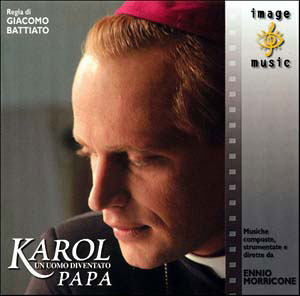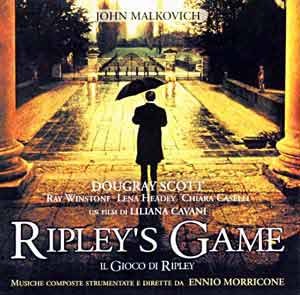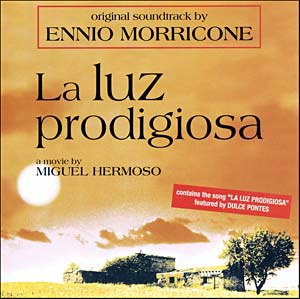The Later Morricone (Part 2/2)
The Later Morricone: Introduction [Review]: Fateless
[Review]: Cefalonia
[Review]: Il Cuore nel Pozzo
[Review]: Karol un uomo diventato Papa
[Review]: Ripley’s Game
[Review]: La Luz Prodigiosa
The Later Morricone: Conclusion
Karol un uomo diventato Papa (2005)
Music composed, orchestrated, and conducted by Ennio Morricone
Performed by Roma Sinfonietta and Lirico Sinfonico Romano, with solos by Fausto Anzelmo (viola), Gilda Butta (pianoforte)
Available on Image Music (ERE-0162902)
Running Time: 58:40

With a timeliness that might betray an accessory to murder under more suspicious circumstances, a new television movie on Karol Wojtyla’s life leading up to his ordination as John Paul II premiered just as the world converged on the Vatican to observe the election of a new pope. Perhaps in the well-appointed liner notes, the director of the Polish/Italian co-production – Giacomo Battiato – explains the awkward feelings that must come with accidentally having your film boosted to the spotlight by the death of its subject. Certainly he’s talking about something in Italian, and it isn’t the fine music Ennio Morricone wrote – the remarks on the composer only a paragraph compared to the pages of thoughts the man has set down here. (Which makes me wonder what a memoir Morricone could write of his experiences… that would be an interesting read.)
Had you asked me at the outset which composer should have scored this film, I would have leaned on the Polish roots of Karol Woktyla and said Krszemir Debski, Zbigniew Preisner, or the legendary Wojciech Kilar (who sadly seems to have been absent from scoring ever since Polanski’s The Pianist). That Polish sound so evident in the works of these three, especially Kilar – stern, folk-based, emotional but minimalist, lyrical – would seem ideal for the blend of humanity and perfection a biopic of the late Pope would have to present. Of course it turns out I was way off – the perfect composer was obvious: Ennio Morricone, scorer of Moses the Lawgiver (1978), Il Papa Buono (2003), ‘Cantico Il Giubelo’ (2000), and the film that defined the sound of modern Catholicism, The Mission (1986).
For indeed any of those other scores save perhaps aspects of ‘Cantico Il Giubelo’, the Jubilee suite Morricone composed for the Catholic Church in 2000. It’s certainly the sternest of the scores reviewed in this retrospective, the dour passage for woodwinds and choir (again Lirico Sinfonico Romano) opening ‘Habemus Papam Giovanni Paolo II’ heavy with the weight of the Cross. After two minutes of choral exploration, that first cue presents the deceptively simple theme for Karol Woktyla – a series of short consecutive ascending and descending phrases doubled on oboe and choir with organ accompaniment, that are as eloquent a musical portrait of humility as I can remember hearing.
This theme for Woktyla is used sparely in the score, dour and lifting at the same time – ‘Karol e la sofferenza’, ‘Karol e il dolore’, and the moving unaccompanied choral final ‘Wyszynski: il Cardinale (reprise)’ the key arrangements. Its lyrical form is interspersed throughout the score between spurts of historical change – the strained trumpet over raging tremolo strings in ‘Contro’, the disturbing rhythms and harmonies of the snare-drum led ‘Karol e gli invasori’, and the weighty string themes of ‘Cracovia’ and the second (and totally different from the first) ‘Karol e gli invasori’. The ‘KGB’ are characterised with a mixture of the composer’s avante-garde ideas and, ironically enough, the same spirit of Investigation of a Citizen Above Suspicion. Morricone’s quirkier side also shows its head – the main themes emerging in an almost amusing dialogue between different sections of the orchestra in ‘L’illusione della liberte’. Equally quirky is the spotting of the main theme in small snatches for fluttering trumpet, strings and the kind organ that usually accompanies vampires in the turbulent highlight ‘Karol e gli operai’. So too, the almost playful dissonance of ‘Polonia in flamme’. The suspense and action writing for this score is probably the best of the six represented here, largely because of the strange blend of the stern material with Morricone’s quirky musical sensibility.
The solo instrument showcased most impressively in this work is the piano. Gilda Butta has performed on so many of the Maestro’s scores that it is no surprise Karol is strong in this regard. There’s a near chamber austerity to the piano solo of ‘Karol e la sofferenza’, before flute and strings enter for a poignant reprise of the main theme. ‘Da una radio lontana’ opens with a solo line for piano over strings, Butta’s dextrous fingers pitching the piece somewhere between classical and improvised, elated and reflective. Though Morricone’s violist Fausto Anzelmo makes an impression with his passion reading of the young pope’s affections in ‘Karol e l’amore’, Butta herself takes both solo and accompaniment parts in ‘Karol e l’amore (reprise)’, a rare winsome interlude in the otherwise elegiac tapestry.
Other highlights include the ethereal piano and strings of the first ‘Wyszynski: il Cardinale’ cue and the harp and oboe-led melody of ‘Maria e Adam’. While it’s not quite as accessible as some of the other scores reviewed here, this is the one that has grown on me the most. The magic of that simple main theme is strange indeed. I can’t quite give it full marks, because I do find myself a little wearied by the album’s end, but I find I’m less wearied with every visit. The album is available for purchase from Intrada and Screen Archives Entertainment, as is the sequel album. (Yes, they’ve already made one, also scored by Morricone.)
Rating:
4.5
Ripley’s Game (2002)
Music composed, orchestrated, and conducted by Ennio Morricone
Performed by Nuova Roma Sinfonietta with Gilda Butta (pianoforte), Gianni Oddi (sax soprano) and Cicci Santucci (flicorno).
Available on Warner Chappell (Warner 256460072-2)
Running Time: 46:50

Morricone’s score for the Liliana Cavani film based on Patricia Highsmith’s third Ripley novel is the only score here that I’ve had the pleasure of enjoying in the context of the film. Cavani’s film is a curious one – I’m told the direction is not the best, and I suppose I have to believe it, because I was too riveted by John Malkovitch’s performance as murderous art dealer Tom Ripley to notice much of the directing. If ever an actor was born to play a role, it’s this, Malkovitch single-handedly dismissing memories of Wim Wenders’ An American Friend with Dennis Hopper. The supporting cast is also strong – Ray Winstone as an old acquaintance in need of the Ripley’s knack for murder, and Dougray Scott as the neighbour who has the double misfortune of contracting terminal cancer and offending Ripley.
Those who view the film are likely to come off thinking of the music as fairly unimpressive, a misconception fuelled by two pieces of temp track that unfortunately remained on the film – a quote from ‘Host of Seraphim’ by Dead can Dance and the soprano solo from the first movement of Gorecki’s Symphony No. 3. Which is a shame, as Morricone’s work here rose to the challenge of supporting the film’s black humour – we must find Ripley funny, despite his horrific deeds. The score again features Nuova Roma Sinfonietta, with regular Morricone collaborator Gilda Butta performing piano and harpsichord solos, and extensive writing for saxophone and flicorno soloists.
The best-scored sequence is without a doubt the train massacre, the two halves of the sequence separated on album – ‘Primo Treno’ and ‘Secondo Treno’. Ripley has for his own perverse amusement persuaded his dying neighbour to become a contract killer to build up an inheritance for his young wife and son. The poor man boards a train in Germany with instructions to garrote a crimelord escorted by several bodyguards. The cue establishes suspense via dissonant brass and an earnest rhythm that is almost a parody of the suspense ostinati typically used in a scene like this. The neighbour waits outside the bathroom, where he will take the man on – only to find Ripley also there, the schemer having taken sympathy on his inexperienced protégé. They wait inside the loo for man – the urgent rhythms building with flutter-tongued brass. When he enters, they grab him – the cue pauses – and then resumes with the parodic rhythm as the death struggle begins. The process continues as the bodyguards come looking, one-at-a-time walking into their death in train toilet overcrowded with corpses. Each time one is taken, Morricone elicits macabre laughter with his clever spotting.
The other highlight on album is the concert arrangement of the piece played by Ripley’s wife Luisa (Chiara Caselli), a famed harpsichordist in the film’s narrative. An intriguing detail in the film is the way the minor celebrity figure of the wife is oblivious, either consciously or not is unclear, to her husband’s amorality – the stress of her upcoming solo performance blinding her to all else. After suggestions of the concert work in ‘Berlino, una sera’ – harpsichord and flute prominently featured - it appears in the last scene of the film as ‘In Concerto’, actually the opening track on the album here. A harpsichord melody unfolds, soon joined by flicorno and Morricone’s yearning string harmonies. It’s a piece that builds and builds, with jazzy solos for the harpsichord mixing with more baroque phrasing – a nice musical metaphor for Ripley’s gifted improvisation within set plans. There’s even a moment for electric guitar in there! The cue is a definite must for fans of the composer – and hopefully will appear on one of those perennial Morricone compilations one of these days.
And there’s a lot more to like here too – one of the Maestro’s most distinctive scores in the last few years. ‘Il Cinismo di Ripley’ and the first ‘Collage de Ripley’ have an almost improvised feel, both featuring a duet for flicorno and saxophone over sharp violin strokes. The score’s most melodic idea first appears in ‘Louise’, a melancholy saxophone theme that speaks to Trevanny’s moral collapse, appearing again in ‘Diagnosi’ and ‘Un Regalo’. And there’s room for Morricone’s traditional suspense writing too – many of the score’s darker ideas gathered together in a near fourteen minute cue also called ‘Collage de Ripley’, which I suspect was meant to accompany some of the climactic scenes ultimately occupied by the temporary music (which couldn’t be more different from this). The latter cue makes for an unresolved ending, though perhaps repeating ‘In Concerto’ at the end of the album would have been too much of a jump for the dour ending of the tale.
A thoroughly worthwhile purchase for fans of the film and the composer’s quirky sense of humour. But see the film first, as it’s increasingly rare and may cost a bit, and also because of all the scores reviewed here, this is the one that most appeals to the head over the heart on first listen. The regular soundtrack retailers are not carrying this one at the moment, something I hope is a temporary situation.
Rating:
4.5
La Luz Prodigiosa (aka End of a Mystery, 2003)
Music composed, orchestrated, and conducted by Ennio Morricone
Performed by Nuova Roma Sinfonietta with Dulces Pontes (vocals), Gilda Butta (piano), Andrea Corsi (bassoon), Fausto Anzelmo (viola), Marco Serino (violin), Patrizio Scarponi (violin) and Michele Chiapperino (cello)
Available on Rai Trade (FRT-407)
Running Time: 55:25

A young man starts to look into the life of a veteran of the Spanish civil war, and believes he’s found Federico Garcia Lorca, a poet of renown. Morricone’s score is a delicate work, performed by Nuova Roma Sinfonietta (mostly the string section), but often highlighting a small ensemble of string quartet, bassoon and piano. These soloists, together with Portuguese singer Dulce Pontes, are the stars of this score – Fausto Anzelmo’s viola, Gilda Butta’s piano, and Andrea Corsi’s bassoon in particular highlighted throughout the score.
The main theme is sung by Pontes in ‘La Luz Prodigiosa’ with lyrics from one of Lorca’s poems – Pontes intensely performing the long-lined melody over an echoing motif that swells first in the piano, then in the full string section. Her voice has much less of a classical feel to Ella Dell’Orso, her considerable range and down-to-earth sound lending the song a unique feel among Morricone’s works. The theme of the song itself is nicely handled by the instrumental soloists in ‘Passato Remoto’, bassoon, viola and piano drawing out the nuances of the melody. ‘Nella casa di F. G. L’ features an intense cello reading of the theme. ‘F.G.L’ features a despondent bassoon reading of the theme; and the full song form is given an orchestral reprise in the concluding ‘A Dulce Luminosa’.
The echoing motif from ‘La Luz Prodigiosa’ is the other main idea in this score, presumably serving as a kind of leitmotif for thoughts of the past – a nice little device that is heard on its own with stern string counterpoint in ‘Ritono dalla memoria’. The echoing idea is performed with variations by the string soloists over string orchestra accompaniment at the opening of ‘Ricerca del pane’, moving into a fugal build of the idea to a gorgeous moment of elation for piano and viola. The cue closes with a string quartet variation on the echoing motif and extended soli for bassoon and viola, the distinct texture of the quartet and its pizzicati a refreshing change from the lusher symphonic sound heard in many of the scores reviewed above.
Other moments of note: the bassoon theme in ‘Secondo Atto’ and the skittish march that surrounds it; the dissonant strings and piano writing of ‘Nei Luoghi’; the lyrical suspense of ‘Dopo il teatro’ (now there’s a novel concept) – complete with quartet orchestrations that suggest Goldenthal; the restrained quartet variations on the main theme in ‘In Biblioteca’. There’s so much to like here, and it’s easy to forget that all the ideas are essentially presented in the first track of the album, so impressively does the composer develop the material.
This was actually the score that got me back into Morricone two years ago. Despite the excellence of the The Legend of 1900 (2000), I lost interest in the composer after that score for a while. (This happens quite often – I go through waves of purchasing Morricone’s scores.) Thankfully I saw this in a Sydney store, and having heard good things, purchased it, as it’s a work of quality dramatic scoring with strong vocal and small ensemble writing. It’s worth checking out Footlight Records to get a copy of this one.
Rating:
5
Go to Part 1 of "The Later Morricone".
Even the least superstitious person would have to wonder whether Morricone’s musical contributions to the Roman Catholic Church have yielded dividends in the form of a long and fruitful career that most others in the profession would kill for. With Lucia (2006) and Karol, un papa rimasto uomo (2006) already available for purchase online, and Libertas (2006) and Tornatore’s Leningrand (2006) on the way, fans of the Maestro have much to look forward to, though whether Morricone 2006 will be as extraordinary a vintage as Morricone 2005 is yet to be seen. I hope to do another one of these retrospectives on the composer towards the end of the year, capturing some of the scores from the last couple of years that have fallen between the cracks – Musashi (2003), Il Papa Buono (2003), Aida degli Alberi (2001) and Metra 72 (2004) among them.
If there’s anything I miss from this latest set of scores, it’s that unhinged mischief that informed so much of Morricone’s early work, and which we really haven’t heard since Oliver Stone’s U-Turn (1997). But as a more traditional orchestral composer, he’s gone from strength to strength, composing, orchestrating and conducting all his own works with a speed and quality that puts most others consistently to shame.
As always, James Southall’s Moviewave is recommended as the most up-to-date English language resource for reviews of recent Morricone releases.
Michael McLennan
Return to Reviews Index